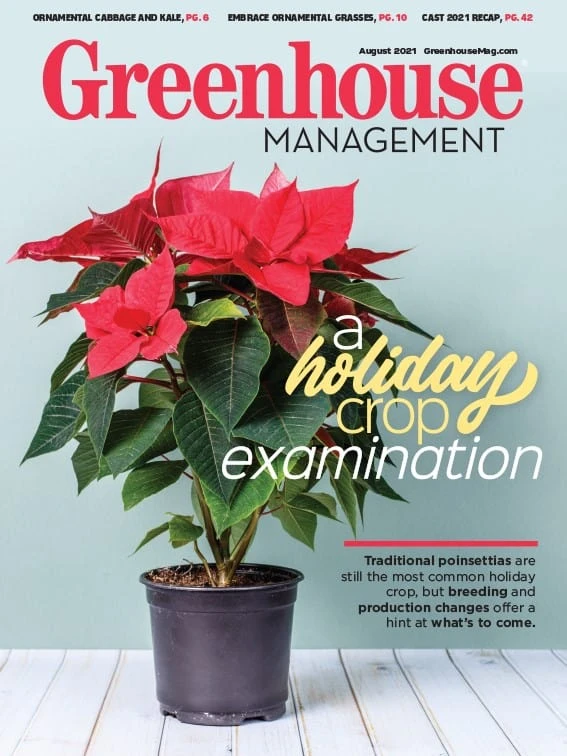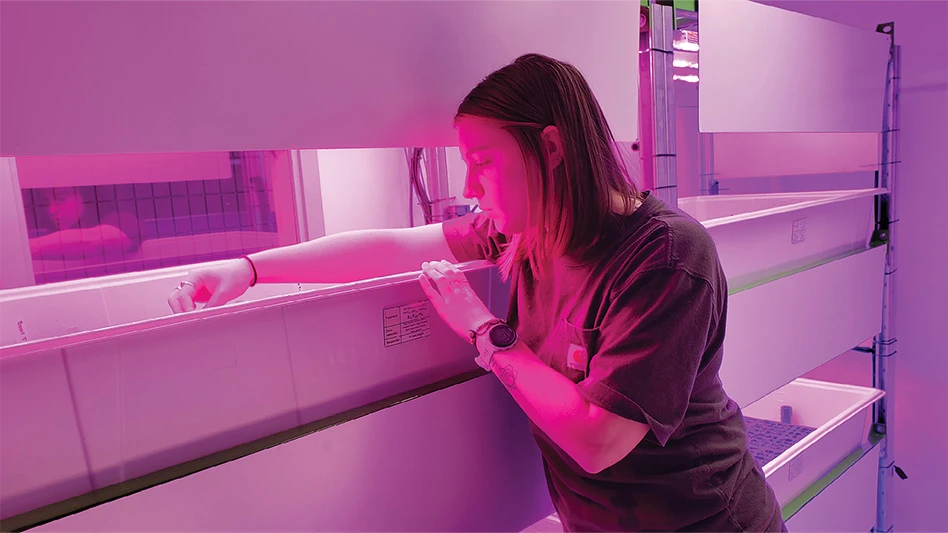
Growers have a lot of choices to consider when selecting lighting systems to produce plants, including efficiency and productivity. Cultivation approach (indoor or greenhouse), technique (single-tier or vertical racking), and cultivar are important factors and can influence which equipment can do the job effectively.
Horticultural lighting is a fast-growing segment of the electric load for many U.S. utility companies, and lighting for indoor cannabis cultivation accounts for much of this growth. The “2018 Cannabis Energy Report,” published by New Frontier Data and co-authored by Resource Innovation Institute (RII) and Scale Microgrid Solutions, estimated that legal cannabis cultivation in the U.S. consumes approximately 1.1 million megawatt hours of electricity annually — enough to power 92,500 homes — and recommended that the industry “evaluate energy-efficient and renewable energy technologies” to rein in its carbon footprint.
The U.S. Department of Energy recommends that growers transition their lighting to light-emitting diode (LED) technology, a move the agency says could reduce electricity usage by at least 40% and save operators approximately $240 million. The industry is poised for the transition; a 2019 Strategies Unlimited report forecasted that the LED market for cannabis will grow more than 300% in the next five years.
Evaluating LED Solutions
Growers who are interested in researching LED technology and looking for unbiased information may want to start with the DesignLights Consortium (DLC), a nonprofit organization with a board of directors that includes leadership from energy and utility companies. The DLC instituted a first-of-its-kind performance standard for horticultural lighting in 2018. The result of two years of stakeholder engagement, the DLC’s Technical Requirements for Horticultural Lighting set standards for efficacy, safety, durability and other criteria that manufacturers must meet to get their LED products included on the DLC’s Horticultural Lighting Qualified Products List (QPL). Currently, listed products are at least 10% more energy efficient than the most efficient legacy grow lights (i.e., double-ended high-pressure sodium (HPS)). The DLC third-party verification process for horticultural lighting does not exist for non-LED lighting solutions like High Intensity Discharge technology (e.g., HPS, metal halide).
The QPL is a searchable, filterable online resource that gives grow light shoppers a map through what can be a confusing landscape of options. With 226 products listed and more reviewed and added regularly, the QPL offers cannabis growers transparent performance data that allows apples-to-apples comparisons of LED fixtures and the ability to verify manufacturers’ marketing claims.
An increasing number of efficiency programs rely on the DLC’s Horticultural QPL for designing energy efficiency (EE) programs for commercial cultivators. Nearly 60 EE programs serving growers in 31 states and four EE programs in Canada require use of QPL-listed products as a prerequisite for EE incentives, and many others have incorporated the DLC Technical Requirements into their programs while not yet requiring listed products. Massachusetts and Illinois, which have cannabis-specific EE regulations, offer use of the DLC Horticultural Lighting QPL as one route for compliance. (The QPL website includes a filter to facilitate cultivators’ search for regulatory-compliant products in these states.)
In addition to efficiency, manufacturers’ longevity and safety claims must be verified for LED fixtures to get listed on the Hort Lighting QPL. Notably:
- Products must be tested at the worst-case electrical scenario. This conservative assessment means that growers who use a listed product at a different voltage may experience better performance than the fixture’s listed performance.
- LEDs must produce a maintained photon output of at least 90% of initial output for at least 36,000 hours — ensuring longer life and lower maintenance costs compared with HPS fixtures.
- Drivers and fans must have a lifetime of at least 50,000 hours, increasing reliability.
- Fixtures must have a warranty of five years.
- Fixtures must be certified by an Occupational Safety and Health Administration (OSHA) Nationally Recognized Testing Laboratory, or Standards Council of Canada (SCC)-recognized body, to meet specific safety benchmarks deemed applicable to horticultural lighting products by that safety organization.
Eighteen months after rolling out its horticultural lighting Technical Requirements, the DLC announced the policy’s first major update in September 2020, scheduled to take effect March 31. This update maintains the current efficacy threshold but adds new optional reporting requirements that extend the performance information to include additional UV and far-red wavelengths, so that in the future the QPL can offer products with more diverse ranges of light recipes. The update also includes use of the ANSI/CAN/UL8800:2019 Safety Standard for Horticultural Lighting Equipment And Systems, which has specific rating requirements for environmental factors such as damp locations, ingress protection codes, photobiological safety ratings, and UV material protection.
The DLC is considering further updates this summer under Version 2.1 that would add three new categories of fixtures to the Horticultural Lighting QPL: DC-powered fixtures, liquid-cooled fixtures, and LED replacement lamps. Look for updates on the DLC’s Horticultural Lighting Program website (designlights.org/horticultural-lighting/).
Bright Questions for Manufacturers
Before growers consider replacing their light fixtures, they should consider creating a baseline of their operation in RII’s benchmarking tool, Cannabis PowerScore, to record their current Key Performance Indicators (KPIs) for energy efficiency, productivity and lighting performance so they know how their operation is performing with their current lighting technology. As they upgrade their lighting systems and potentially transition to LED solutions, they should continue to benchmark their facility periodically to quantify the benefits with PowerScore, verifying the improvements in their KPIs to measure their success.
RII’s analysis of aggregate PowerScore data shows that indoor cannabis cultivation operations growing with LED for flowering achieve 34% better average electric facility efficiencies and 80% better average electric production efficiencies than indoor facilities using double-ended (DE) HPS lighting for the flowering growth stage.
Growers who are ready to evaluate lighting solutions and the manufacturers serving their market should ask suppliers:
- What is the warranty of your product?
- What is the rated fixture life and control equipment life? What tests were performed to validate the claim?
- Has your product been tested on my cultivar(s)?
- What is the spectral quantum distribution (SQD) of your product, and does it align with my desired light recipe?
- Can you provide Photosynthetic Photon Intensity Distributions (PPID) to show the photosynthetic light emitted at different angles so I can plan lighting layouts? (The PPID allows you to create your own lighting plans rather than relying on the manufacturer.)
- What technical assistance is available during the design phase for lighting plans?
- What help can you provide if I encounter problems during production?
- Is there a cost for technical support or limitations on when/how to access it?
When growers ask suppliers about LED lighting solutions, they should verify whether the products are DLC-listed. Growers can note that SQD and PPID images are provided for LED products on DLC’s Horticultural Lighting QPL. If a product is DLC-listed, cultivators can ask the manufacturer about their experience getting help from utilities with rebates to buy down the first cost. In 2018, the average cost of flowering LED fixtures was around $1,500 compared to conventional HID lighting solutions like HPS, which cost around $500 on average in 2018 and have continued to decrease in price faster than LED products, according to market research completed by RII member Energy and Resource Solutions. First cost of LED products can be a barrier to adopting this emerging technology.

Measuring LEDs Effect on Plant Expression
A challenge of using LED horticultural lighting can be understanding how it stimulates plant responses like photosynthetic action and secondary metabolite production. Predictive metrics like PPF or photosynthetic photon efficacy (PPE) are, as the names indicate, based on light-stimulating photosynthesis.
The metrics used by RII, DLC, fixture manufacturers and others are standardized by the American Society of Agricultural and Biological Engineers (ASABE). These metrics do not predict light’s ability to produce other responses, like the production of specific secondary metabolites such as CBD, THC and terpenes.
In the U.S., research organizations are studying hemp production, sometimes in collaboration with lighting manufacturers, and publishing results for different spectral combinations and light amounts. At this time, no metrics considering the interactive effects of spectrum and dose on specific secondary metabolites have been proposed.
RII and DLC hope that additional metrics will begin to be considered and developed, so that cultivators can better predict which lighting system is going to help them optimize the biological results. In the meantime, the industry continues to use photosynthetic metrics and empirical data to inform additional desired outcomes.
Improved facility efficiency and productivity are possible with LED horticultural lighting solutions, as they save energy, while more non-energy benefits are yet to be researched and quantified. Tested and certified LED products on the DLC QPL can be relied upon for cultivation, so growers should consider the variety of trustworthy options on the DLC QPL when they make their next lighting purchase.
Anticipating and Overcoming the LED Learning Curve
Another challenge of using LED horticultural lighting can be navigating the learning curve of LED technology and modifying Standard Operating Procedures (SOPs) when necessary. There are a few considerations during design and construction that can optimize grow environments to be adaptable and successful as growers use their new equipment, and peer-reviewed guidance is available to help them maintain productivity. RII’s LED lighting best practices guide offers tips for successful installation and operation of LED products. RII’s Massachusetts best practices guide offers tailored recommendations for a market that is adopting LED lighting. Download both guides at ResourceInnovation.org/Resources.

Explore the August 2021 Issue
Check out more from this issue and find your next story to read.
Latest from Greenhouse Management
- USDA fires experts on invasive pests, including Asian citrus psyllid, chilli thrips
- CEA Alliance celebrates bipartisan introduction of Supporting Innovation in Agriculture Act
- Dümmen Orange North America celebrating 25th anniversary in 2025
- CEA HERB Part 1: Best management practices for culinary herbs
- Lawsuit challenges new H-2 visa rules
- CEA HERB Part 2: A guide to increasing the sowing density of culinary herbs
- Illinois Landscape Contractors Association changes name to Landscape Illinois
- 2025 Proven Winners Horticulture Scholarship applications now open







